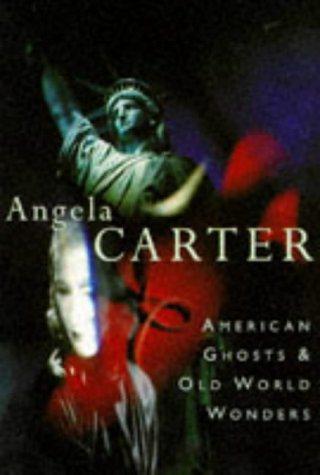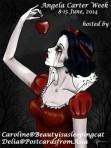
I’m sure we all read because we like a good story but aren’t we equally keen on writing which ignites our imagination? Writing that connects us with our subconscious, our emotions and dreams? Angela Carter knows how to tell a story but more than that, she inspires. She makes us think, explore, dream, fantasize, question. Sometimes it’s not even important to understand every aspect of her short fiction but just to read one of her wonderful sentences, discover one of her splendid images is enough.
The short story collection American Ghosts and Old World Wonders is such a treasure trunk. It’s full of retellings, deconstruction, parodies, reimagining of old myths, fables and fairy tales. It wasn’t always a breezy read. I had to hunt for a few academic papers in order to fully understand the one or the other of the pieces in this book. Like in all of her collections, there were a few stories that stood out and I’ve even found a new favorite.
In this collection Angela Carter mixes myths and elements of the American Dream and/or of America as the land of dreams, the country of one of the biggest movie industries, the country of serial killers and westerns, of endless possibilities, and juxtaposes these elements with stories from the old world – fairy tales and history. The result is stunning.
The book is divided in two parts. I’d call the first the “American” part and the second the “Old World” part.
Part I
Lizzie’s Tiger is the second Lizzie Borden story she wrote. It shows us a young fearless Lizzie who discovers the magical world of a circus and a tiger who’s living in it. It’s as much an allusion to Blake’s famous poem as it is an imagination of a time when Lizzie was still small and had options to become someone else.
John Ford’s ‘Tis Pity She’s a Whore is a pretty tongue-in-cheek and cheeky piece. What if the film director John Ford made British playwright John Ford’s drama ‘Tis Pity She’s a Whore into a movie? Well – read her story and you’ll find out what that would be like.
Gun for the Devil is another Western type story set near the Mexican border. Johnny get’s a gun and frees a girl. Sort of. The story contains an allusion to the movie Johnny Got His Gun.
The Merchant of Shadows is my favorite story in the book and has become one of my all-time favourites. A story of decay, exuberance, mystery, set in a decadent Hollywood setting, reminiscent of Sunset Boulevard (one of my favorite movies btw). A young academic comes to interview the widow of the famous film director von Mannheim (he seems inspired by von Sternheim). His widow was once a femme fatale but now she’s in a wheelchair, living with her sister who looks like a cowboy.
Here are is a sample of this deliciously lush and weird story, which contains a lot of Angela Carter’s magic, including metafiction, allusions, cultural references and a lot more:
A flight of rough-cut stone steps led up to a pool surrounded by clumps of sweet-smelling weeds; I recognised lavender. A tree or two dropped late summer leaves on scummy water and, when I saw that pool, I couldn’t help it, I started to shiver; I’ll tell you why in a minute. That untended pool, in which a pair of dark glasses with one cracked lense rested on an emerald carpet of algae, along with an empty gin bottle.
On the terrace a couple of rusty, white-enamelled chairs, a lopsided table. Then, fringed by a clump of cryptomeria, the house von Mannheim caused to be erected for his bride.
That house made the Bauhaus look baroque. An austere cube of pure glass, it exhibited the geometry of transparency at its most severe. Yet, just at that moment, it took all the red light of the setting sun into itself and flashed like a ruby slipper. I knew the wall of the vast glittering lounge gaped open to admit me, and only me, but I thought, well, if nobody has any objections, I’ll just stick around on the terrace for a while, keep well away from that glass box that looks like nothing so much as the coffin for a classical modernist Snow White; let the lady come out to me.
No sound but the deep, distant bass of the sea; a gull or two; pines, hushing one another.
So I waited. And waited. And I found myself wondering just what it was the scent of jasmine reminded me of, in order to take my mind off what I knew damn well the swimming pool reminded me off – Sunset Boulevard, of course. And I knew damn well, of course I knew, that this was indeed the very pool in which my man Hank Mann succumbed back in 1940, so very long ago, when not even I nor my blessed mother, yet, was around to so much as piss upon the floor.
I waited until I found myself growing impatient. How does one invoke the Spirit of Cinema? Burn a little offering of popcorn and old fan magazines? Offer a libation of Jeyes’ Fluid mixed with Kia Ora orange?
This passage shows something else that strikes me every time when I read Angela Carter – how she is at the same time irreverent and full of admiration for her themes.
I liked the stories in part II a little less.
The Ghost Ships – A Chritsmas Story, I didn’t really get it but it had a few great moments. This opening for example:
‘Twas the night before Christmas. Silent night, holy night. The snow lay deep and crisp and even. Etc. etc. etc.; let these familiar words conjure up the traditional anticipatory magic of Christmas Eve, and then – forget it.
Then In Pantoland – a parody of the way fairy tales have become a pure commodity, robbed of their deeper meaning and sometimes violent aspects due to the way Disney has used them.
Ashputtle or The Mother’s Ghost contains three ways to deconstruct Ashputtle. Very different from Disnye’s Cinderalla.
Alice in Prague or The Curious Room is an homage to a Czech filmmaker. It combines Dr Dee and Alice in Wonderland. Edward Kelly is called Ned Kelly. I didn’t really understand what this figure of Australian history got to do in this text. I really love this passage:
Night was. Widow Night, an old woman in mourning, with big, black wings, came beating against the window; they kept her out with lamps and candles.
Impressions: The Wrightmans Magdalene is the reimagining of the story of Mary Magdalene. It references two artists’ representation: Georges de La Tour’s Mary Magdalene and Donatello’s Mary Magdalene. One a painting, the other a sculpture.
This collection was a wild ride, at times challenging, but mostly really captivating and enchanting.
This is the second review for Angela Carter week, co-hosted with Delia (Postcards from Asia).
PLEASE ADD YOUR OWN REVIEWS TO THE MR LINKY HERE

